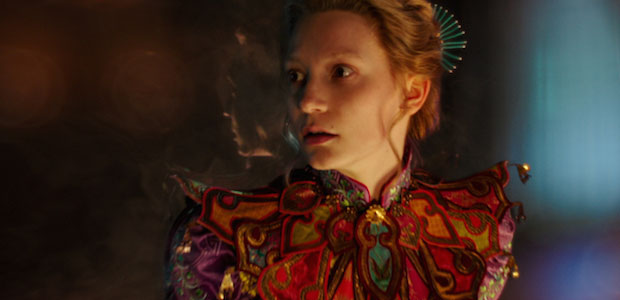For years, it seemed like Hollywood was using a shocking amount of restraint, not making a sequel to Tim Burton’s 2010 film Alice In Wonderland. After all, while the movie did manage to make more than a billion dollars at the global box office, it also was far from the most warmly-embraced title in Burton’s filmography. Now, however, we have director James Bobin’s Alice Through The Looking Glass, and while the best we could have hoped for was that Disney spent the last six years developing the script for the perfect follow-up, the sad truth is that the end result feels little more than frivolous and an unfortunate use of a lot of talented people’s time.
Appropriately picking up a few years after the first one, Alice Through The Looking Glass begins as Alice Kingsleigh (Mia Wasikowska) returns home after spending a great deal of time away sailing the world as the captain of her own ship. As she once again finds herself being pulled in all directions, forced to either sign a new deal with Hamish Ascot (Leo Bill) or lose her boat, she also once again gets distracted by adventures in Underland.
After a brief reunion with Absolem (voiced by Alan Rickman) convinces Alice to step through the mirror back into the fantasy realm, she discovers that all is not right with her favorite pals – particularly Tarrant Hightopp a.k.a. The Mad Hatter (Johnny Depp). After discovering the first hat he ever made buried in the dirt – something he considers entirely impossible – the Hatter becomes convinced that his family didn’t die during the Jabberwocky attack on Horovendoush Day, but is instead alive. Everyone failing to believe this story drives Hatter into a dark state and near death, leading Alice only one choice: to steal a magical device called the Chronosphere from Time himself (Sacha Baron Cohen), and travel back into history to find out what really happened. This same Chronosphere, as it turns out, has also become an item hotly pursued by the notorious Red Queen (Helena Bonham Carter), who has her own reasons for wanting to meddle with the past.
As you can tell, Alice Through The Looking Glass takes its title from the sequel novel written by Lewis Carroll, but beyond a few moments, it changes that original story completely – replacing it with one that really fails to ever be compelling. Not only does it seem like an incredibly forced effort to shove Johnny Depp’s Mad Hatter into the spotlight, but the movie even has to make ridiculous and out-of-character steps in order to make the plot work (in the opening scene, Alice scorns a member of her crew for using the word “impossible” to describe a sailing maneuver, and then finds herself using it herself just a few sequences later in conversation with the Hatter about his family). It doesn’t successfully add any larger depth to the world established with the first movie, which is really one of the greatest sins a years-late sequel can commit, given that it only intensifies the “why did they bother?” question.
Obviously one of the most significant change-overs from Alice In Wonderland to Alice Through The Looking Glass is James Bobin replacing Tim Burton at the helm, but what unfortunately can’t and doesn’t disappear is the larger aesthetic for the franchise. The new director did incorporate the greater use of practical sets in the production sequel, and does manage to set up some memorable and exciting sequences – such as the large-scale naval battle that serves as the opening– but the movie once again lives on the cusp of CGI overload, and elements are dizzyingly over stylized. There are some natural improvements over the predecessor that simply comes from technology advancing over the last six years, but that only helps things so much.
While Alice In Wonderland was ultimately brought down by its shockingly listless pacing and narrative, Alice Through The Looking Glass at least keeps things interesting with the occasional cool sequence, fun with sci-fi concepts and interesting performances. The movie actually takes steps to establish certain rules for its approach to time travel, elegantly working in harmony with larger themes about our perception of time and its hold over us. Sacha Baron Cohen puts on a memorable, seemingly Werner Herzog-inspired performance in the antagonist role (his tea party sequence shared with the Mad Hatter being genuinely delightful), and Helena Bonham Carter once again seems like she’s having a blast as the petulant Red Queen. These positive aspects simply can’t make up for the film’s other shortcomings.
In the last few years, Disney has had some incredible success with live-action films based on films in their famed animated catalog – including Maleficent, Cinderella and The Jungle Book - but Alice Through The Looking Glass will hopefully be the end of the line for this iteration of Alice in Wonderland. It’s too bad that sleeping dogs couldn’t be let to lie, and the end result is a less-than-mediocre follow-up with a small handful of interesting ideas.
Your Daily Blend of Entertainment News

Eric Eisenberg is the Assistant Managing Editor at CinemaBlend. After graduating Boston University and earning a bachelor’s degree in journalism, he took a part-time job as a staff writer for CinemaBlend, and after six months was offered the opportunity to move to Los Angeles and take on a newly created West Coast Editor position. Over a decade later, he's continuing to advance his interests and expertise. In addition to conducting filmmaker interviews and contributing to the news and feature content of the site, Eric also oversees the Movie Reviews section, writes the the weekend box office report (published Sundays), and is the site's resident Stephen King expert. He has two King-related columns.

